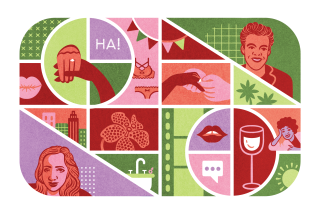Proposal Reversal : Is it just leap year, or a change of heart in society? Women are taking charge in all things romantic.
- Share via
DANA POINT — It is Valentine’s Day at a fancy hotel restaurant. The dining room is filled with couples, and the romance in the air is so thick that it feels as if Cupid has just passed through on an uncontrolled rampage of love.
Bright red and pink balloons float from railings. Roses are strewn everywhere. Hands reach across tables for two and softly touch. And in a dimly lit corner of the room--a proposal.
Cindy Vanderweide and Ron Burns were friends for several years before they fell in love 11 months ago. Since September, the 27-year-old flight attendant and the 26-year-old fireman have discussed marriage. Tonight, Burns is as close as he has ever been to proposing.
The couple order drinks, then an appetizer. The shrimp cocktails are pecked at, courage is mustered, then finally the woman speaks: “Honey, we’ve been talking about this for a long time. Let’s get married.” Caught completely by surprise, Burns can only blink for a few seconds before smiling broadly and nodding his acceptance.
Welcome to leap year, 1992.
Time has faded the popularity of the centuries-old leap year tradition that encourages women to turn the tables and propose marriage. In 1992, it’s an archaic notion that brings a smile to the lips. Yet, the concept refuses to die.
Recently, the Dana Point Resort sent out several thousand flyers directed at women, publicizing a romantic weekend at the hotel. Their message: “In a leap year, ladies take responsibility for making the marriage proposal. So ladies prepare, and men beware!”
So far, the hotel is nearly sold out on weekends through leap year day, Feb. 29, and 90% of the reservations have been made by women, said Penny Elia, hotel spokesperson.
“I think in this society that it’s time women be allowed to exercise responsibility,” Elia said. “Women should take the initiative and turn the tables occasionally. We came up with this idea as a marketing plan, but it didn’t turn out to be as bloodless as that. A lot of people have taken some real pleasure from this.”
Although they say women often book family vacation plans, some in the travel industry are noticing an upswing in reservations made by women during romantic holidays.
“We started doing some research this year, and a real good share are women,” said Mark Wylie, a sales agent for California Riviera 800, a Laguna Beach travel agency that specializes in booking rooms at luxury coastal hotels. “I think the times are changing a lot. It’s not uncommon now for women to call up and plan the getaways and do more take-charge in their relationships.
“Some call us and are almost embarrassed to be (making room reservations),” Wylie said. “Then they say: ‘Hey, why not. It’s the ‘90s.’ Personally, I think it’s great. I think men enjoy being surprised.”
About 85% of 4,000 men between ages 18 and 26 polled would accept if proposed to, according to a survey published by the makers of Brylcreem last December. Some 10% would decline without hesitation, and 5% “would run” if they received a proposal of marriage.
Vanderweide was reasonably sure that Burns wouldn’t bolt. She was sure enough to have gone shopping with her mother to pick up a wedding dress and plan a romantic evening at the Dana Point Resort that included dinner and a stay in the Presidential Suite.
“I was confident because we’ve been friends for so long,” she said. “It really doesn’t bother me that I didn’t wait for him to ask. I thought, ‘We can talk about how wonderful it would be (to get married) the rest of our lives.’ I didn’t want to wait.”
Not that Vanderweide didn’t have last-minute doubts.
“There’s always that part that says, ‘Well, I’m just not ready.’ But if you don’t take chances, you never get anywhere.”
Burns could tell something was a little different when they arrived at the restaurant.
“She was nervous during dinner,” he said with a smile. “Now, I know why. I think that’s good; now she knows how we feel. Men have to ask for the date first, we have to go for the kiss first.”
Still, Burns couldn’t help but feel some disappointment over not making the proposal.
“I was close to proposing,” he said. “It might have been next month, next week or even tomorrow.”
But “the important thing is that we love each other and we’re going to live the rest of our lives together.”
Both Burns and Vanderweide described themselves as quiet, traditional-minded people.
Vanderweide said her proposal was “not really indicative of my character. I’m really pretty conservative and proper. In high school, my friends all thought I’d be the first to get married and have the house and white-picket fence. My family and I are pretty excited, but some of my friends will probably be shocked.”
Burns agreed that his fiancee is a quiet person. “That’s why (the proposal) surprised me so much.” But still, “Cindy has a lot of class. She is very much a lady.”
But like several other couples at the resort last weekend, Burns and Vanderweide hadn’t heard of leap year proposals.
“It didn’t make much difference to me,” Vanderweide said. “These are the ‘90s.”
Legend has it that the leap year tradition began in the 5th Century and almost developed into one of history’s great love stories.
A woman later canonized as St. Bridget complained to St. Patrick, a bishop at the time, that the women of the land had no right to ask a man for his hand in marriage.
St. Patrick is said to have turned down her request to change the law. St. Bridget persisted, and he finally agreed to grant permission for the turnabout once every seven years. Not good enough, said St. Bridget. Finally they agreed on every four years, on leap year day.
Fair enough, said St. Bridget, who then popped the question to St. Patrick. The bishop turned her down but sent a silk dress as an apology.
Over time, the practice became law in several European countries, starting in 13th Century Scotland. Many twists and permutations of the original concept grew, such as a tradition in England that required a woman to make the proposal wearing a red petticoat with a small portion of the undergarment showing. Some scholars believe this was the source of the expression “scarlet woman.”
Through the last half of the 20th Century, the tradition has begun to disappear somewhat, say folklore experts. The cultural strengthening of women in modern society and the increasing popularity of Valentine’s Day has helped overshadow the leap year proposal.
“There are major changes going on in society,” said Diane Ross, coordinator of the women’s studies program at Cal State Fullerton. “Customs are changing, and women are being empowered to make their own decisions. Particularly, younger women really do know who they are, and their identity is not dependent on their relationship with the man.”
Ross pointed to other fading traditions as an example.
“We’ve moved away from a man going to the father for permission to marry his daughter,” Ross said. “That’s good, because it moves away from the idea of ownership of a woman. At weddings I’ve been to over the last 10 years, I’ve seen less giving away of the brides and a lot of couples writing their own vows. Some of the taboos that say ‘women can’t do this, or, men can’t do that’ don’t exist.
“Those traditional roles people have been thrust into are changing. The leap year proposal is a tradition that’s dying.”
But not if people such as Elia can help it. Instead of waiting four years for the next leap year opportunity, the hotel might run another promotion aimed at women next Valentine’s Day.
“We’ve gotten so much response from women this year, I say, ‘Why not?’ ” asked Elia. “Why not start a new tradition?”
More to Read
Sign up for The Wild
We’ll help you find the best places to hike, bike and run, as well as the perfect silent spots for meditation and yoga.
You may occasionally receive promotional content from the Los Angeles Times.






